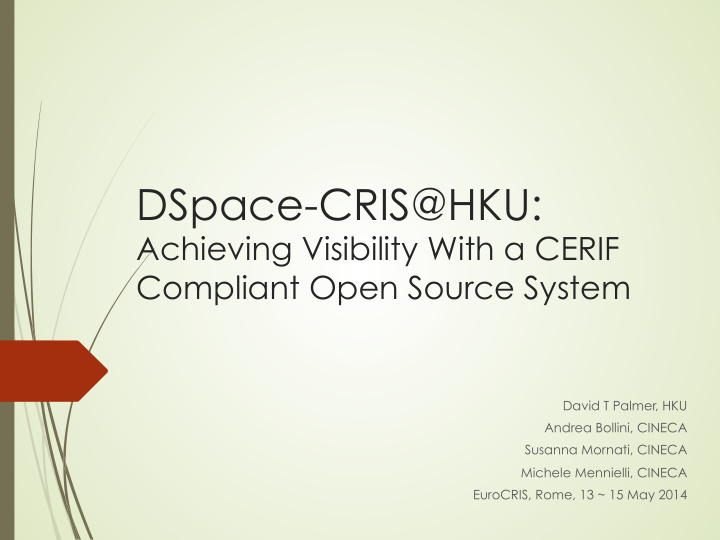



DSpace-CRIS@HKU: Achieving Visibility With a CERIF Compliant Open Source System David T Palmer, HKU Andrea Bollini, CINECA Susanna Mornati, CINECA Michele Mennielli, CINECA EuroCRIS, Rome, 13 ~ 15 May 2014
University of Hong Kong (HKU) IR è CRIS ´ 2005. Traditional IR. Publications in OA ´ The HKU Scholars Hub “The Hub” ´ 2009. “Knowledge Exchange” (KE) ´ “Engaging our community for mutual benefit” ´ OA & KE complimentary ´ The Hub: a key vehicle for HKU’s KE ´ Provides visibility on items previously in dark archive ´ Gradually, dynamically, & organically, ´ Decision support; funding, research management ´ Benchmarking with peers; HKU and beyond
Extending Dspace è Dspace-CRIS Relational Tables: top level objects & attributes • Article title Publications • Publication year, etc. • Name(s) Researchers • Department, etc. • Headship Organizations • Sub-units, etc. UI: Mashes Up to show integrated display
Sources; dark & external HKU (dark) db External db Registry Personnel Elsevier Scopus Research Publications TR WoS -- ditto Grants RePEc -- ditto Awards SSRN Public Affairs Media NIH PubMed Contact dir. Tech Transfer Patents Faculty 1000 Grad School Thesis USPTO supervision Espacenet Patent Lens
The HKU Scholars Hub (The Hub) -- A Current Research Information System (CRIS) HKU Sources Individual scholars • - Registry Individual Depts • - Research Services - Graduate School - Public Affairs - Tech Transfer External Sources - Scopus, - WoS, ResearchID - SSRN - ACM Digital Library - Google Scholar Citations Librarians - Etc.
Data model ENTITIES FEW PREDEFINED APPROACH UIs ATTRIBUTES DYNAMIC FLEXIBLE FEW DEFINE ANY NOT HARDCODED PREDEFINED ASPECTS Standard --> publications & dataset / ResearcherPage Dspace / Project DSpace-CRIS --> other CERIF / OrgUnit entites: / 2nd Level Dynamic Object
Defining a DSpace-CRIS Entity ´ UUID ´ Public flag ´ Dynamic Properties: each property can hace its own PropertyDefinition ´ System administrator can decide: ´ Repeatable ´ Mandatory ´ Underlying storage data type: String, int, double, date, html link, link to other entities ´ Start / End date ´ Scope: link to a Semantic/Classification Object (itself a DynamicObject) ´ Nested object: can be repeatable, mandatory, and hold a list of other nested properties
Main DSpace-CRIS Entities ResearcherPage ´ To manage researcher profiles; ´ Structural relations with System Users and pre-configured properties to manage name variants; ´ Managed out-of-box by non-system administrators. Project and OrgUnit ´ Defined as separate entities; ´ Easy to develop future extensions, specializations, specific workflow and editing rules Second level Dynamic Object ´ A single entity identified by a profile (type) as Journal, Prize, Event, etc.; ´ Each profile can have its own set of properties and nested objects independently defined
CERIF compliance ´ Key components of CERIF Data Model are supported natively: semantic UUID timestamped relation charecterization ´ The Data Model flexibility shows how to configure instances with CERIF Data Model. ´ The level of compliance depends on the configuration adopted by the Institution ´ Some de-normalizations are recommended ´ easy to adapt when data is already available in other systems (i.e. Journal information stored in the publication record or funding information stored in the project record).
A note on DSpace Metadata model DSpace is known to support out-of-box the Dublin Core Initiative Work to update from the current LoC profile provided with DSpace to a dcterms schematic is in progress DSpace metadata model is not bound to DC, Qualified DC or any other schematic
CERIF Compatibility ´ Base configuration to map CRIS entities without making the system too complex for Universities. ´ Further configurations could be provided as sample / addon for advanced users. ´ Any installation will be able to map their specific configuration to CERIF using UI. ´ A n:m mapping will be supported where a single DSpace-CRIS entity instance could be translated to more CERIF Entities and viceversa.
DSpace metadata: a different point of view .. the technical agnostic one… ´ Any metadata is characterized by a schema, element and qualifier but… ´ schema = bibliografic information, administrative metadata, etc.; ´ element = relation with people; ´ qualifier = the semantic of the relationship (author, editor, etc.) ´ Which metadata are available, which repeatable and which mandatory is defined by configuration ´ When allowed by the configuration, any metadata can hold a reference to another object (eg. Authority synonymies & hierarchies)
Outcomes, Intended & Unexpected ´ KE: Visibility on HKU research, community engaged ´ KE: Dspace-CRIS ´ Open Source, Many players, mutual benefit ´ Assist: Hong Kong Research Assessment Exercise (RAE) 2014 ´ Support: HKU Manangement Information Unit ´ Designated: HKU Data Archive ´ Repurposed: HKU Library Cataloguing Dept
This PPT & PDF are licensed under the Creative Commons Attribution “CC-BY” license. This license permits use of this work, so long as attribution is given. For more information about the license, visit • http://creativecommons.org/licenses/by/3.0/ Archived at, • http://hdl.handle.net/10722/197028 David T Palmer • http://hub.hku.hk/cris/rp/rp00001 • http://orcid.org/0000-0001-5616-4635 Andrea Bollini Susanna Mornati Michele Mennielli
Recommend
More recommend